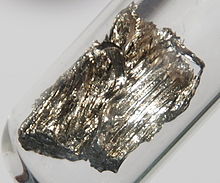Rare earths are indispensable for numerous products and industrial processes. Most modern technologies would be unimaginable without the 17 rare earth elements.
Samarium is one of these important elements. It was discovered only at the end of the 19th century. But today samarium is needed in many industries.
Samarium – a rare earth element
The material group of rare earths comprises a total of 17 elements. Samarium is one of these elements and, like all rare earth metals, does not occur in its natural form as a single element.
Instead, samarium is found in some minerals, such as monazite, bastnäsite, or samarskite, along with other rare earth elements. Monazite, for example, can contain up to 1 percent samarium.
Samarium is extracted using complex technologies such as ion exchange, solvent extraction and electrochemical deposition.
Versatile use
The yellowish silver-colored metal is the hardest and the most brittle element from the rare earth group. In the air, samarium tarnishes and it ignites at about 150 degrees Celsius.
Due to its special properties, samarium is used in many ways. For example, samarium is an important component in samarium-cobalt permanent magnets or in glass that absorbs infrared radiation. It is also used in X-ray lasers and catalysts for the production of ethanol.
Similarly, samarium is essential in the manufacture of carbon lamps and as an absorber in nuclear reactors. In addition, it is successfully used in the treatment of pain associated with bone cancer.
Samarium is found in many small technical devices such as voice recorders Walkmans, headphones or hard disk drives. Samarium is therefore indispensable for a correspondingly large number of industries.
Where to find samarium
What applies to all rare earth elements also applies to samarium – rare earths are not as rare as the name suggests. They can be found all over the world, but they are only extracted in a few places on this earth.
Around 95 percent of all rare earths are extracted in China. The largest deposit of samarium and other rare earths is located near the Chinese industrial city of Baotou in Inner Mongolia. There, mining takes place in the huge Bayan Obo mine.
Huge deposits but environmental problems from extraction
Although the ore deposit in Inner Mongolia supplies nearly 95 percent of all rare earths, experts suspect that many times the amount of rare earths produced is present in the earth’s crust worldwide.
Experts currently estimate that there are around 100 million tons of rare earths, and more than a few suspect that rare earths could become as important as oil in the future.
The fact that mining does not take place in many places is mainly due to the fact that the extraction of rare earths entails major environmental problems. The elements are extracted from the ore rock with the help of strong acids. This process produces toxic sludge, which is stored in artificial ponds and poses great dangers to the environment and people.







